Biofuel

| Part of a series on |
| Renewable energy |
|---|
 |
Biofuel is a
In general, biofuels emit fewer
Global demand for biofuels is predicted to increase by 56% over 2022-2027.[9] By 2027 worldwide biofuel production is expected to supply 5.4% of the world's fuels for transport including 1% of aviation fuel.[10] Demand for aviation biofuel is forecast to increase.[11][12]
The two most common types of biofuel are bioethanol and biodiesel. Brazil is the largest producer of bioethanol, while the EU is the largest producer of biodiesel. The energy content in the global production of bioethanol and biodiesel is 2.2 and 1.8 EJ per year, respectively.[13]
Bioethanol is an
Biodiesel is produced from oils or fats using transesterification. It can be used as a fuel for vehicles in its pure form (B100), but it is usually used as a diesel additive to reduce levels of particulates, carbon monoxide, and hydrocarbons from diesel-powered vehicles.[14]
Terminology
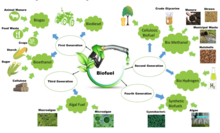
The term biofuel is used in different ways. One definition is "Biofuels are biobased products, in solid, liquid, or gaseous forms. They are produced from crops or natural products, such as wood, or agricultural residues, such as molasses and bagasse."[2]: 173
Other publications reserve the term biofuel for liquid or gaseous fuels, used for transportation.[3]
The
Conventional biofuels (first generation)
First-generation biofuels (also denoted as "conventional biofuels") are made from food crops grown on arable land.[16][17]: 447 The crop's sugar, starch, or oil content is converted into biodiesel or ethanol, using transesterification, or yeast fermentation.[18]
Advanced biofuels
To avoid a "
The feedstock used to make the fuels either grow on arable land but are byproducts of the main crop, or they are grown on marginal land. Second-generation feedstocks also include straw, bagasse, perennial grasses, jatropha, waste vegetable oil, municipal solid waste and so forth.[20]
Types
Liquid
Ethanol
Biologically produced
Ethanol fuel is the most common biofuel worldwide, particularly
Other bioalcohols
Methanol is currently produced from
Biodiesel
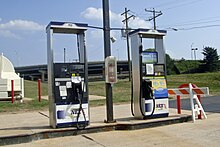
Biodiesel is the most common biofuel in Europe. It is produced from oils or fats using
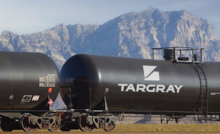
Biodiesel can be used in any diesel engine and modified equipment when mixed with mineral diesel. It can also be used in its pure form (B100) in diesel engines, but some maintenance and performance problems may occur during wintertime utilization, since the fuel becomes somewhat more viscous at lower temperatures, depending on the feedstock used.[30]
Electronically controlled '
Biodiesel is an
In many European countries, a 5% biodiesel blend is widely used and is available at thousands of gas stations.
Green diesel
Straight vegetable oil

Straight unmodified edible vegetable oil is generally not used as fuel, but lower-quality oil has been used for this purpose. Used vegetable oil is increasingly being processed into biodiesel, or (more rarely) cleaned of water and particulates and then used as a fuel. The IEA estimates that biodiesel production used 17% of global vegetable oil supplies in 2021.[21]
Oils and fats reacted with 10 pounds of a short-chain alcohol (usually methanol) in the presence of a catalyst (usually sodium hydroxide [NaOH] can be
Biogasoline
Biogasoline can be produced biologically and themochemically. Using biologicalical methods, a study led by Professor Lee Sang-yup at the Korea Advanced Institute of Science and Technology (KAIST) and published in the international science journal Nature used modified E. coli fed with glucose found in plants or other non-food crops to produce biogasoline with the produced enzymes. The enzymes converted the sugar into fatty acids and then turned these into hydrocarbons that were chemically and structurally identical to those found in commercial gasoline fuel.[50] The thermochemical approach of producing biogasoline are similar to those used to produced biodiesel.[39][40][41] Biogasoline may also be called drop-in gasoline or renewable gasoline.
Bioethers
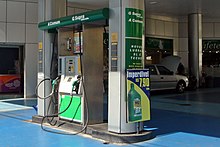
Bioethers (also referred to as fuel
In transportation fuel there are six ether additives: dimethyl ether (DME), diethyl ether (DEE), methyl tert-butyl ether (MTBE), ethyl tert-butyl ether (ETBE), tert-amyl methyl ether (TAME), and tert-amyl ethyl ether (TAEE).[55]
The European Fuel Oxygenates Association identifies MTBE and ETBE as the most commonly used ethers in fuel to replace lead. Ethers were introduced in Europe in the 1970s to replace the highly toxic compound.
Aviation biofuel
An
Biofuels are
Aviation biofuel can be produced from plant or animal sources such as
Gaseous
Biogas and biomethane
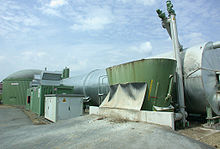
Biogas is a mixture composed primarily of
Biogas can be recovered from mechanical biological treatment waste processing systems. Landfill gas, a less clean form of biogas, is produced in landfills through naturally occurring anaerobic digestion. If it escapes into the atmosphere, it acts as a greenhouse gas.
In Sweden "waste-to-energy" power plants capture methane biogas from garbage and use it power transport systems.[67] Farmers can produce biogas from cattle manure via anaerobic digesters.[68]
Syngas
Syngas, a mixture of carbon monoxide, hydrogen and various hydrocarbons, is produced by partial combustion of biomass (combustion with an amount of oxygen that is not sufficient to convert the biomass completely to carbon dioxide and water).[49] Before partial combustion the biomass is dried and sometimes pyrolysed. Syngas is more efficient than direct combustion of the original biofuel; more of the energy contained in the fuel is extracted.
Syngas may be burned directly in internal combustion engines,
Syngas can be used to produce methanol, dimethyl ether and hydrogen, or converted via the Fischer–Tropsch process to produce a diesel substitute, or a mixture of alcohols that can be blended into gasoline. Gasification normally relies on temperatures greater than 700 °C.
Lower-temperature gasification is desirable when co-producing biochar, but results in syngas polluted with tar.
Solid
The term "biofuels" is also used for solid fuels that are made from biomass, even though this is less common.[3]
Research into other types
Algae-based biofuels
Algae can be produced in ponds or tanks on land, and out at sea.
By 2017, due to economic considerations, most efforts to produce fuel from algae have been abandoned or changed to other applications.[80]
Electrofuels and solar fuels
This class of biofuels includes
Third and fourth-generation biofuels also include biofuels that are produced by bioengineered organisms i.e. algae and cyanobacteria.[82] Algae and cyanobacteria will use water, carbon dioxide, and solar energy to produce biofuels.[82] This method of biofuel production is still at the research level. The biofuels that are secreted by the bioengineered organisms are expected to have higher photon-to-fuel conversion efficiency, compared to older generations of biofuels.[82] One of the advantages of this class of biofuels is that the cultivation of the organisms that produce the biofuels does not require the use of arable land.[83] The disadvantages include the cost of cultivating the biofuel-producing organisms being very high.[83]
Bio-digesters
A bio-digester is a mechanized toilet that uses decomposition and sedimentation to turn human waste into a renewable fuel called biogas. Biogas can be made from substances like agricultural waste and sewage.[84][85] The bio-digester uses a process called anaerobic digestion to produce biogas. Anaerobic digestion uses a chemical process to break down organic matter with the use of microorganisms in the absence of oxygen to produce biogas.[86] The processes involved in anaerobic respiration are hydrolysis, acidogenesis, acetogenesis, and methanogenesis.[87]
Extent of production and use
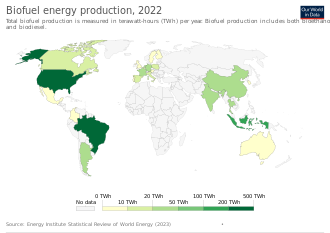
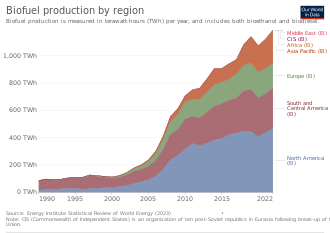
Global biofuel production was 81
An assessment from 2017 found that: "Biofuels will never be a major transport fuel as there is just not enough land in the world to grow plants to make biofuel for all vehicles. It can however, be part of an energy mix to take us into a future of renewable energy."[4]: 11
In 2021 worldwide biofuel production provided 4.3% of the world's fuels for transport, including a very small amount of aviation biofuel.[10] By 2027 worldwide biofuel production is expected to supply 5.4% of the world's fuels for transport including 1% of aviation fuel.[10]
The US, Europe, Brazil and Indonesia are driving the majority of biofuel consumption growth. This demand for biodiesel, renewable diesel and biojet fuel is projected to increase by 44% (21 billion litres) over 2022-2027.[89]
Issues
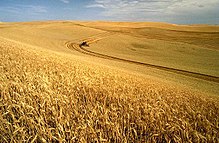
This article needs to be updated. (March 2024) |
This article has an unclear citation style. (July 2023) |
Environmental impacts
Estimates about the climate impact from biofuels vary widely based on the methodology and exact situation examined.[6]
In general, biofuels emit fewer
The use of second generation biofuels is thought to increase environmental sustainability, since the non-food part of plants is being used to produce second-generation biofuels, instead of being disposed.[97] But the use of second-generation biofuels increases the competition for lignocellulosic biomass, increasing the cost of these biofuels.[98]
Third generation biofuels, produced from Algae, in theory shouldn't have as negative an impact on the environment than first or second generation biofuels, due to lower changes in land use and not requiring pesticide use for production.[99] When looking at the data however, it has been shown that the environmental cost to produce the infrastructure and energy required for third generation biofuel production, is higher than the benefits provided from the biofuels use.[100]
The European Commission has officially approved a measure to phase out palm oil-based biofuels by 2030.[101][102] Unsustainable palm oil agriculture has caused significant environmental and social problems, including deforestation and pollution.
The production of biofuels can be very energy intensive, which if generated from non-renewable sources can heavily mitigate the benefits gained through biofuel use. A solution proposed to solve this issue is to supply biofuel production facilities with excess nuclear energy, which can supplement the energy provided by fossil fuels.[103] This can provide a carbon inexpensive solution, to help reduce the environmental impacts of biofuel production.
Indirect land use change impacts of biofuels
This article needs to be updated. (August 2021) |
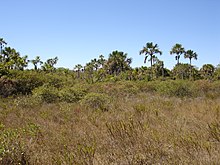

The
As farmers worldwide respond to higher crop prices in order to maintain the global food supply-and-demand balance, pristine lands are cleared to replace the food crops that were diverted elsewhere to biofuels' production. Because natural lands, such as rainforests and grasslands, store carbon in their soil and biomass as plants grow each year, clearance of wilderness for new farms translates to a net increase in greenhouse gas emissions. Due to this off-site change in the carbon stock of the soil and the biomass, indirect land use change has consequences in the greenhouse gas (GHG) balance of a biofuel.[104][105][106][107]
Other authors have also argued that indirect land use changes produce other significant social and environmental impacts, affecting biodiversity, water quality, food prices and supply, land tenure, worker migration, and community and cultural stability.[106][108][109][110]See also
- Bioenergy Europe
- BioEthanol for Sustainable Transport
- Biofuels Center of North Carolina
- Biogas powerplant
- International Renewable Energy Agency
- List of biofuel companies and researchers
- List of vegetable oils used for biofuel
- Renewable energy by country
- Renewable Energy Transition
- Residue-to-product ratio
- Sustainable aviation fuel
- Sustainable transport
- Table of biofuel crop yields
References
- ^ "Biofuel | Definition, Types, & Pros and Cons | Britannica". www.britannica.com. 18 March 2024. Retrieved 2 April 2024.
- ^ OCLC 1137604985.)
{{cite book}}: CS1 maint: location missing publisher (link - ^ a b c "Biofuels explained - U.S. Energy Information Administration (EIA)". www.eia.gov. Retrieved 24 January 2023.
- ^ OCLC 1137604985.)
{{cite book}}: CS1 maint: location missing publisher (link - ^ S2CID 134824935.
- ^ PMID 33363439.
- ^ PMID 35165202.
- PMID 33363439.
- ^ "Biofuel is approaching a feedstock crunch. How bad? And what must be done?". Energy Post. 23 January 2023. Retrieved 14 March 2024.
- ^ a b c "Transport biofuels – Renewables 2022 – Analysis". IEA. Retrieved 30 January 2023.
- ^ "Biofuel is approaching a feedstock crunch. How bad? And what must be done?". Energy Post. 23 January 2023. Retrieved 30 January 2023.
- ^ "How to scale Sustainable Aviation Fuel in the next decade". World Economic Forum. Retrieved 30 January 2023.
- ^ "Renewables Report 2022". IEA.
- S2CID 238787289.
- ^ a b IPCC, 2022: Annex I: Glossary [van Diemen, R., J.B.R. Matthews, V. Möller, J.S. Fuglestvedt, V. Masson-Delmotte, C. Méndez, A. Reisinger, S. Semenov (eds)]. In IPCC, 2022: Climate Change 2022: Mitigation of Climate Change. Contribution of Working Group III to the Sixth Assessment Report of the Intergovernmental Panel on Climate Change [P.R. Shukla, J. Skea, R. Slade, A. Al Khourdajie, R. van Diemen, D. McCollum, M. Pathak, S. Some, P. Vyas, R. Fradera, M. Belkacemi, A. Hasija, G. Lisboa, S. Luz, J. Malley, (eds.)]. Cambridge University Press, Cambridge, UK and New York, NY, USA. doi: 10.1017/9781009157926.020
- PMID 36996247.
- ^ OCLC 1137604985.)
{{cite book}}: CS1 maint: location missing publisher (link - ^ "What are – and who's making – 2G, 3G and 4G biofuels? : Biofuels Digest - biofuels, biodiesel, ethanol, algae, jatropha, green gasoline, green diesel, and biocrude daily news". 21 May 2010. Archived from the original on 21 May 2010.
- ^ European Parliament. "Advanced biofuels" (PDF). Retrieved 19 April 2024.
- ^ "Biofuels – Second Generation Biofuels". biofuel.org.uk. Archived from the original on 15 July 2019. Retrieved 18 January 2018.
- ^ a b "Is the biofuel industry approaching a feedstock crunch? – Analysis". IEA. Retrieved 2 January 2023.
- doi:10.2172/1218382.
- ^ Börjesson P, Lundgren J, Ahlgren S, Nyström I (18 June 2013). Dagens och framtidens hållbara biodrivmedel: underlagsrapport från f3 till utredningen om fossilfri fordonstrafik [Today's and the future's sustainable biofuels: background report from f3 to the inquiry into fossil-free vehicle traffic.] (Report) (in Swedish). Vol. 13. The Swedish Knowledge Centre for Renewable Transportation Fuels. p. 170.
- ^ "ButylFuel, LLC Main Page". Butanol.com. 15 August 2005. Archived from the original on 10 July 2019. Retrieved 14 July 2010.
- ^ Evans J (14 January 2008). "Biofuels aim higher". Biofuels, Bioproducts and Biorefining (BioFPR). Archived from the original on 10 August 2009. Retrieved 3 December 2008.
- PMID 30107263.
- PMID 16233120.
- ^ "Perstop Press release: Verdis Polaris Aura – second generation B100 – The advanced green one". Archived from the original on 4 August 2014. Retrieved 21 June 2014.
- ^ Lee T (7 June 2020). "Safflower oil hailed by scientists as possible recyclable, biodegradable replacement for petroleum". ABC News. Landline. Australian Broadcasting Corporation. Archived from the original on 7 June 2020. Retrieved 7 June 2020.
- ^ "Alternative Fuels Data Center: Biodiesel Blends". afdc.energy.gov. Retrieved 31 March 2022.
- ^ Nylund NO, Koponen K (2012). Fuel and Technology Alternatives for Buses. Overall Energy Efficiency and Emission Performance. IEA Bioenergy Task 46 (PDF) (Report). VTT Technical Research Centre of Finland. Archived from the original (PDF) on 16 February 2020.. Possibly the new emission standards Euro VI/EPA 10 will lead to reduced NOx-levels also when using B100.
- ^ "Biofuels Facts". Hempcar.org. Archived from the original on 20 May 2011. Retrieved 14 July 2010.
- ^ "ADM Biodiesel: Hamburg, Leer, Mainz". Biodiesel.de. Archived from the original on 2 August 2009. Retrieved 14 July 2010.
- ^ RRI Limited for Biodiesel Filling Stations. "Welcome to Biodiesel Filling Stations". Biodieselfillingstations.co.uk. Archived from the original on 14 July 2018. Retrieved 14 July 2010.
- ^ a b Avril Group : Activity Report 2014, p. 58
- ^ EurObserv 2014, p. 4
- ^ Brown R, Holmgren J. "Fast Pyrolysis and Bio-Oil Upgrading" (PDF). Archived (PDF) from the original on 5 January 2012. Retrieved 15 March 2012.
- ^ a b c d "Alternative & Advanced Fuels". US Department of Energy. Archived from the original on 27 October 2012. Retrieved 7 March 2012.
- ^ a b "Technology | Comsyn". www.comsynproject.eu. Retrieved 19 April 2024.
- ^ ISSN 1385-8947.
- ^ ISSN 2352-5509.
- ^ from the original on 6 November 2012. Retrieved 23 August 2012.
- ^ "Green Diesel v. Biodiesel". Archived from the original on 5 August 2018. Retrieved 5 August 2018.
- ^ Jessica E. "Breakthroughs in Green Gasoline Production". Biomass Magazine. Archived from the original on 11 March 2012. Retrieved 14 August 2012.
- ^ Albrecht KO, Hallen RT (March 2011). A Brief Literature Overview of Various Routes to Biorenewable Fuels from Lipids for the National Alliance of Advanced Biofuels and Bio-products NAAB Consortium (PDF) (Report). Prepared by the US Department of Energy. Archived (PDF) from the original on 12 July 2012. Retrieved 23 August 2012.
- ^ "Preem makes major investment in green diesel at the Port of Gothenburg – Port of Gothenburg". August 2014. Archived from the original on 1 August 2014.
- ^ "Wal-Mart To Test Hybrid Trucks". Sustainable Business. 3 February 2009. Archived from the original on 8 May 2014. Retrieved 8 May 2014.
- ^ "Alternative Fuels Data Center: Biodiesel Production and Distribution". afdc.energy.gov. Retrieved 31 March 2022.
- ^ National Non-Food Crops Centre. Archived from the originalon 11 June 2008.
- ^ Liquid Transport Fuels&Lubes - South Korean scientists use E. coli to make gasoline (Report). Fuels&Lubes Daily. 4 November 2013. Archived from the original on 7 September 2022.
- ^ Rock K, Korpelshoek M (2007). "Bioethers Impact on the Gasoline Pool". Digital Refining. Archived from the original on 14 November 2016. Retrieved 15 February 2014.
- ^ "Biofuels - Types of Biofuels - Bioethers". biofuel.org.uk. Archived from the original on 1 February 2016.
- ^ "Council Directive 85/536/EEC of 5 December 1985 on crude-oil savings through the use of substitute fuel components in petrol". Eur-lex.europa.eu. Archived from the original on 21 May 2011. Retrieved 14 July 2010.
- ^ "Impact Assessment of the Proposal for a Directive of the European Parliament and of the Council modifying Directive 98/70/EC relating to the quality of petrol and diesel fuels" (PDF). Brussels: Commission of the European Communities. 31 January 2007. Archived (PDF) from the original on 15 July 2011. Retrieved 14 July 2010.
- ^ Sukla MK, Bhaskar T, Jain AK, Singal SK, Garg MO. "Bio-Ethers as Transportation Fuel: A Review" (PDF). Indian Institute of Petroleum Dehradun. Archived (PDF) from the original on 14 October 2011. Retrieved 15 February 2014.
- ^ "What are Bio-Ethers?" (PDF). . The European Fuel Oxygenates Association. Archived from the original (PDF) on 6 March 2014.
- ^ "Gasoline". Environmental Protection Agency. Archived from the original on 6 December 2013. Retrieved 6 March 2014.
- ^ "Biofuels – Types of Biofuels – Bioethers". Archived from the original on 1 February 2016. Retrieved 30 May 2015.
- ^ "Sustainable aviation fuel market demand drives new product launches". Investable Universe. 4 December 2020. Retrieved 12 December 2022. Note: Investable Universe>About
- .
- ^ "Developing Sustainable Aviation Fuel (SAF)". IATA.
- CiteSeerX 10.1.1.170.8750.
- ^ IATA (December 2023). "Net zero 2050: sustainable aviation fuels – December 2023". www.iata.org/flynetzero. Archived from the original on 24 February 2024.
- ^ Mark Pilling (25 March 2021). "How sustainable fuel will help power aviation's green revolution". Flight Global.
- ISSN 0961-9534.
- ^ "A Detailed Economic Assessment of Anaerobic Digestion Technology and its Suitability to UK Farming and Waste Systems (Andersons)". National Non-Food Crops Centre. 4 October 2008. NNFCC 08-006. Archived from the original on 4 October 2008. Retrieved 2 January 2023.
- ISSN 0362-4331. Retrieved 14 March 2024.
- ^ "BIOGAS: No bull, manure can power your farm." Farmers Guardian (25 September 2009): 12. General OneFile. Gale.
- ^ Nagel F (2008). Electricity from wood through the combination of gasification and solid oxide fuel cells (PhD thesis). Swiss Federal Institute of Technology Zurich. Archived from the original on 13 March 2011.
- ^ a b "Biofuel from Algae: The Pros and Cons of Pond Scum". Thomasnet®. Archived from the original on 6 April 2020. Retrieved 25 October 2020.
- ^ "Biomass - Offshore wind farms = seaweed = biofuel". Renewable Energy Magazine, at the heart of clean energy journalism. 14 September 2020. Archived from the original on 27 July 2020. Retrieved 16 October 2020.
- PMID 20031983.
- S2CID 111115884.
- PMID 24140355.
- PMID 20675125. Archived from the original(PDF) on 27 February 2012.
- ^ Cornell CB (29 March 2008). "First Algae Biodiesel Plant Goes Online: 1 April 2008". Gas 2.0. Archived from the original on 18 June 2019. Retrieved 10 June 2008.
- hdl:11503/1330.
- ^ Demirbas AH (2009). "Inexpensive oil and fats feedstocks for production of biodiesel". Energy Education Science and Technology Part A: Energy Science and Research. 23: 1–13.
- .
- ^ Wesoff E (19 April 2017). "Hard Lessons From the Great Algae Biofuel Bubble". Archived from the original on 5 July 2017. Retrieved 5 August 2017.
- ISSN 1754-5692.
- ^ PMID 26667057.
- ^ S2CID 116245776.
- PMID 28965912.
- PMID 32889316.
- ISSN 2095-221X.
- ISSN 1364-0321.
- ^ "Biofuel energy production". Our World in Data. Retrieved 15 August 2023.
- ^ "Is the biofuel industry approaching a feedstock crunch? – Analysis". IEA. Retrieved 13 March 2024.
- ^ Towards sustainable production and use of resources: Assessing Biofuels Archived 2016-05-13 at the Portuguese Web Archive, 2009, International Resource Panel, United Nations Environment Programme
- ^ "Indonesia's biodiesel drive is leading to deforestation". BBC News. 8 December 2021.
- ^ "Press corner". European Commission - European Commission. Retrieved 19 April 2024.
- ^ "Biomass Strategy 2023". GOV.UK. Retrieved 19 April 2024.
- ^ "Food vs fuel: Ukraine war sharpens debate on use of crops for energy". Financial Times. 12 June 2022. Archived from the original on 10 December 2022.
- ^ "Guest view: Global hunger fight means no biofuel". Reuters. 6 June 2022.
- ^ "Cutting biofuels can help avoid global food shock from Ukraine war". New Scientist. 14 March 2022.
- S2CID 84426763.
- S2CID 212954432.
- ISBN 978-0-323-90971-6.
- ^ Magazine H. "Biofuel Made from Algae Isn't the Holy Grail We Expected". Hakai Magazine. Retrieved 31 March 2024.
- ^ "Palm Oil Exporter Indonesia Concerned by EU's Deforestation Law". Jakarta Globe. 22 May 2022.
- ^ "EU palm oil use and imports seen plummeting by 2032". Reuters. 8 December 2022.
- ISSN 0096-3402.
- ^ S2CID 52810681. Originally published online in Science Express on 7 February 2008 available here Archived 2009-12-11 at the Wayback Machine
- ^ a b Michael Wang, Zia Haq (14 March 2008). "Letter to Science about Searchinger et al. article" (PDF). Argonne National Laboratory. Archived from the original (PDF) on 15 February 2013. Retrieved 7 June 2009. The published version on Science Letters is included in Searchinger E-Letter responses 2008-08-12
- ^ a b Gnansounou, et al. (March 2008). "Accounting for indirect land-use changes in GHG balances of biofuels: Review of current approaches" (PDF). École Polytechnique Fédérale de Lausanne. Retrieved 7 June 2009. Working Paper REF. 437.101
- ^ Alexander E. Farrell (13 February 2008). "Better biofuels before more biofuels". San Francisco Chronicle. Retrieved 7 June 2009.
- PMID 18267903. Published on line 2008-02-11.
- ^ Naylor, et al. (November 2007). "The Ripple Effect: Biofuels, Food Security, and the Environment". Environment. Retrieved 7 June 2009.
- S2CID 40785300.
Sources
- Avril Group, ed. (2015). A new springtime for the oils and proteins sectors : Activity Report 2014 (PDF) (Report). Paris: Avril. p. 65. Archived from the original (PDF) on 26 October 2020. Retrieved 11 August 2022.
- EurObserv (July 2014). Biofuel barometer (PDF) (Report).
External links
- Biofuels Journal
- Alternative Fueling Station Locator Archived 14 July 2008 at the EERE)
- Towards Sustainable Production and Use of Resources: Assessing Biofuels by the United Nations Environment Programme, October 2009.
- Biofuels guidance for businesses, including permits and licences required on NetRegs.gov.uk
- How Much Water Does It Take to Make Electricity?—Natural gas requires the least water to produce energy, some biofuels the most, according to a new study.
- International Conference on Biofuels Standards – European Union Biofuels Standardization
- Biofuels from Biomass: Technology and Policy Considerations Thorough overview from MIT
- The Guardian news on biofuels
- The US DOE Clean Cities Program – links to the 87 US Clean Citiescoalitions, as of 2004.
- Biofuels Factsheet by the University of Michigan's Center for Sustainable Systems
- Learn Biofuels – Educational Resource for Students

